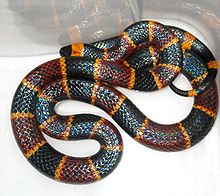Micrurus fulvius
| Micrurus fulvius | |
|---|---|
 |
|
| Scientific classification | |
| Kingdom: | Animalia |
| Phylum: | Chordata |
| Class: | Reptilia |
| Order: | Squamata |
| Suborder: | Serpentes |
| Family: | Elapidae |
| Genus: | Micrurus |
| Species: | M. fulvius |
| Binomial name | |
|
Micrurus fulvius (Linnaeus, 1766) |
|
| Synonyms | |
Micrurus fulvius, the Eastern coral snake,common coral snake, American cobra, or more, is a species of venomous elapid snake endemic to the southeastern United States. It should not be confused with the scarlet snake (Cemophora coccinea) or scarlet kingsnake (Lampropeltis elapsoides), which are harmless mimics. No subspecies are currently recognized.
Generally less than 80 cm (31 in) in length, its maximum reported length of 121.8 cm (48.0 in) was for a specimen in Florida (Niell, 1958) and 129.5 cm (51.0 in) (Roze, 1996). Males have longer tails than females, but females reach a greater total length.
The dorsal scales are smooth in 15 rows. The ventral scales number 197-217 in males and 219-233 in females. There are 40-47 subcaudals in males and 30-37 in females. The anal plate is divided.
The color pattern consists of a series of rings that encircle the body: wide red and black rings separated by narrow yellow rings. The head is black from the rostral to just behind the eyes. The red rings are usually speckled with black. People who live in its natural range are often taught a folk rhyme as children: "Red next to black, safe from attack, red next to yellow, you're a dead fellow," or "Red touching black, friend of Jack; red touching yellow, you're a dead fellow". The rhyme is useful in teaching children to distinguish king snakes (Lampropeltis ssp.), which are considered helpful predators of vermin such as rats and mice, from this much more dangerous snake that should only be handled by an experienced biologist or herpetologist. However, this rhyme is only applicable to the North American species, and cannot be used reliably in the Caribbean, or Central or South America.
Among the many common names for this snake are the eastern coral snake,American cobra, candy-stick snake, common coral snake, coral adder, Elaps harlequin snake, Florida coral snake, harlequin coral snake, North American coral snake, red bead snake, thunder-and-lightning snake, and, in Spanish, serpiente-coralillo arlequín (lit. "harlequin coral snake").
...
Wikipedia

